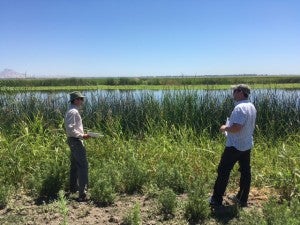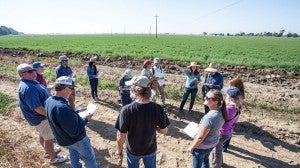
Giant garter snake (license)
Enter the giant garter snake. The giant garter snake is an aquatic species native to California and a federally-listed “threatened” species that largely persists today – along with many other critters – in the vast acreage of Central Valley rice fields and water distribution canals.
In the past, seasonal floods would transform California’s Central Valley into a great inland sea of floodplain habitats teeming with fish and wildlife, including the giant garter snake.
Over time, development of the flood and irrigation systems that enabled the Central Valley’s $17 billion agricultural economy has led to the destruction of 95 percent of the region’s historic wetlands, putting countless California wildlife at risk of extinction.
For example, ongoing flood system operations and maintenance activities—required to protect farms and communities in the floodplain—continue to disrupt giant garter snake habitat. What’s more, when drought or fallowing reduces water deliveries to rice growers, the snake’s remaining habitat can dry up.
We need a better way to protect and restore habitat for wildlife like the giant garter snake, before it’s too late.
A balancing act

Biologists and conservationists examine giant garter snake habitat at Davis Ranch in Colusa, California. Read more about conservation activities at Davis Ranch.
California policymakers are facing a dilemma: how does the state continue to grow its economy, manage its water supply and build necessary infrastructure without eliminating wildlife from the landscape?
Currently, local agencies have to mitigate for impacts to listed species like the giant garter snake when necessary measures—like levee repairs—degrade its habitat. Only with great expense and significant time investment can agencies complete these routine activities due to the planning, permitting and paperwork required to meet species’ needs.
Fortunately, new tools and policies are emerging that can bring more efficiency and certainty to mitigation efforts.
New tools can help
For starters, a multi-stakeholder effort has been underway for the last several years in California with the goal of improving the process for protecting and restoring wildlife habitat. It’s called the Central Valley Habitat Exchange, also described as “Airbnb for wildlife.”
The core of the Central Valley Habitat Exchange is the habitat quantification tool, which has been designed for multiple species.

EDF staff join farmers and other conservation collaborators in the field to test the habitat quantification tool.
To extend the Airbnb analogy, the giant garter snake habitat quantification tool is like the set of preferences the snake would fill out to find its perfect home. The tool takes into account the snake’s most vital habitat needs in order to rigorously measure or predict habitat quality at various sites. The outcome? Everyone from farmers to flood agencies is equipped with the information they need to manage their lands and projects in a way that would earn them a five-star review from the snake (and fish and wildlife agencies).
Flood agencies, for instance, can use the tool to guide the design and implementation of a multiple-benefit flood protection project. These projects reduce flood risk and enhance species habitat in one fell swoop.
Levee set-backs are a perfect example. These projects can expand floodplain habitat that is beneficial to the snake. Instead of shuttling water downstream, they allow it to spread over land to mimic the historic conditions giant garter snakes loved so much. The tool can help predict exactly how much this new inundation will help the snake, as well as other species like salmon.
Unfortunately, even with this methodology available, there is limited incentive for agencies to pursue such projects in a way that provides the greatest habitat benefit.
A policy to align incentives
Ordinary mitigation practices require local agencies to make up for habitat lost, or debits, on a project-by-project basis, often by buying credits from third parties. There is thus little motivation to plan for future mitigation needs ahead of time, even though investments in species improvements on farmland can more than make up for the impacts of ongoing farm activities.
Because costs of habitat restoration can be high, if landowners and agencies can’t get certain credit for maximizing species components—like replanting or grading habitat areas for frequent inundation—they have no economic reason to do so.

California State Capitol (license)
A concept called advance mitigation could change this paradigm by allowing agencies to proactively develop and preserve the best habitat to mitigate for future projects.
Assembly Bill 2087 (Levine), which passed out of the California Senate Appropriations Committee on Thursday and is headed to the Senate floor, creates guidelines for regional conservation frameworks that would enable agencies to pursue advance mitigation projects on land that they or their ratepayers own. The habitat quantification tool is uniquely suited to help these projects demonstrate progress towards the measurable restoration objectives integral to these frameworks.
By combining new tools with new policy, California is creating a win-win for the economy and the environment.
Related:
How can we better target public funds for wildlife conservation? Look to Elliott Ranch >>
Birds, snakes and butterflies: Farming for more than crops and cash >>
Why two California farms give me hope for the monarch butterfly >>










5 Comments
State & federal farmland re-purchase programs are essential. Agencies & NGO’s (The Nature Conservancy) must continue purchasing California farmland as it becomes available. There are thousands of amazing farms available for sale online (landandfarm.com/LoopNet.com). Buying farms opens-up millions of acres of land already designed for irrigated habitat. The Farmland re-purchase movement makes more water available for the environment and urban water users. Fewer farms provides more water for snakes, fish & wildlife.After the gold rush farmers were encouraged with land to ‘settle the West’ and they did it. Now in the 21st century we can restore California back to its origins fast by buying California farms and restoring them back to their pristine condition.
Thanks for raising these good points. Taking advantage of opportunities to make more water available for the state’s communities and ecosystems is without doubt necessary to support their collective water security. However, I’m optimistic that, with the right incentives in place, today’s owners of California farms and ranches can play a central role in doing so while also maintaining their lands’ productivity.
Unfortunately, only the good incentives go to the agencies, non-profits & NGO’s. They specifically EXCLUDE farmers & ranchers, and that because it’s rooted in environmental justice. What’s being offered to farmers is more trouble than its worth to them. They participate in silly programs out of appeasement hoping for some regulatory relief. Anyone with the cash is free to buy farm & ranch land and create as much habitat as they can. But why aren’t they? Donors to the NRDC give huge sums of cash to cut water to farmers which then creates dust bowls. You only have to look to the Sierra to understand what “protecting” the forests has done. Flying over California looks like scorched earth and it wasn’t climate change or the bark beetle which caused it. Even the refuges have been cut off from water! Simply said environmental justice and conservation doesn’t mix and never will. It’s a ruse which has only created social chaos. It hasn’t saved the spotted owl from the barred owl. It hasn’t saved the delta smelt from the striped bass, catfish or salmon. If all this enormous cash was being used to buy farms & ranches, and people were hired to maintain the habitat, there’d be lots more of it. Whoever imagined they were going to make Park Rangers out of farmers & ranchers by not paying them anything made a gross miscalculation.
Back to farmland re-purchase. If a similar approach to settling the West were applied to transitioning farmland back to nature then the donor class should get on with it. Bankrupting all the farmers in the West to confiscate their land will be long and expensive. We’re not under apartheid here.
Responding to both your points here. The goal of the Central Valley Habitat Exchange–and habitat exchanges nationwide–is to do what you mention: pay farmers and ranchers to grow and maintain quality habitat, just as they would grow a traditional crop. It’s true that programs providing this kind of incentive have not been widely available to landowners to date. But, by changing that, we hope that farmers and ranchers will find it profitable to maintain crop production and simultaneously optimize the habitat value of their fields and waterways. Policies like AB 2087 can make this even more financially viable in California. While there is no silver bullet to recovering the West’s at-risk species, we think bringing in landowners as part of the solution is an opportunity worth pursuing alongside more traditional conservation. Thanks again for your thoughts and comments.